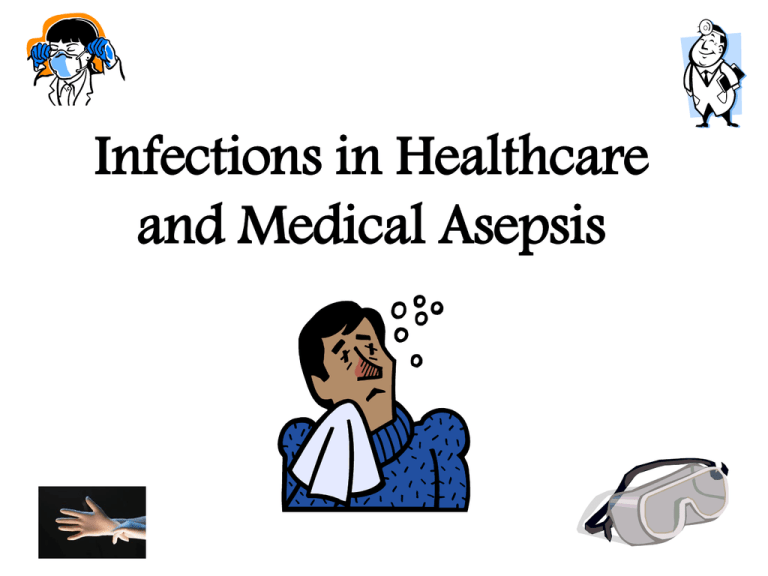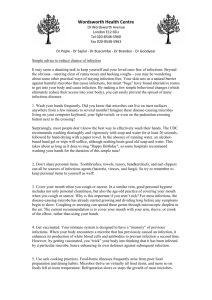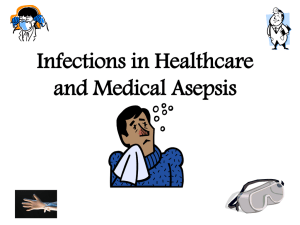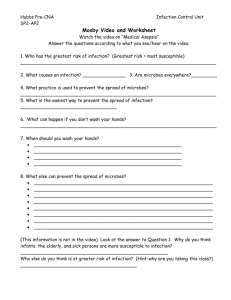Infections in Healthcare and Medical Asepsis
advertisement

Infections in Healthcare and Medical Asepsis Toronto hospital’s persistent bacterial infection outbreak blamed on ‘state-of-the-art’ sinks Helen Branswell, Canadian Press | Jul 25, 2012 8:07 AM ET An investigation aimed at pinpointing the source of a lingering bacterial outbreak in a Toronto hospital turned up an unlikely suspect. The sinks did it. State-of-the-art handwashing sinks installed in the intensive care unit and some patient rooms in Toronto’s Mount Sinai Hospital actually became the reservoir of a pesky drug-resistant bug that infected or colonized 66 patients from the fall of 2006 to the spring of 2011. The outbreak involved Klebsiella oxytoca, a bacterium that normally lives in the human gut. It typically causes urinary tract infections, but can also trigger bacteremia — infection in the blood. Dr. Allison McGeer, Mount Sinai’s head of infection control and senior author of the study, says hospitals know that as a rule these bacteria spread from a patient who is carrying them to other patients. Find the colonized patient — a person carrying Klebsiella oxytoca (KO) but not sickened by them — and make sure he or she is treated in isolation, and you can prevent transmission. That’s the way it’s supposed to work. And using anal swabs, the hospital staff did locate people carrying the bacteria. But despite taking the appropriate measures, the bug continued to spread. When ICU patients became infected even though there were no KO carriers in the ICU, it became clear there had to be a non-human source. Then began a process of elimination. In the Mount Sinai outbreak, McGeer’s team believes sinks became contaminated when staff used them to dispose of body fluids. Not urine, she says, but perhaps fluid from chest tubes or half-used IV bags. “There’s a lot of fluid that needs to be disposed of from ICU patients from a whole variety of sources,” she says. McGeer says in the end some relatively simple changes to the mechanics of the sinks seem to have solved the problem. Drains are now covered by screens with smaller holes, to minimize the potential for back splash. The overflow drains were blocked and traps were moved further back from the basin. Infections in Healthcare Settings • Nosocomial infection: infection acquired after admission to a health care facility - microbes can enter body through equipment used in treatments, therapies and tests (equipment must be free of pathogens) Factors that increase the risk of infection: • • • • • • • Young and old are at risk Poor nutrition Lack of sleep The presence of disease or illness Certain medication Invasive procedures Open wounds Most common infections • Respiratory tract infections (cold, pneumonia, bronchitis, influenza) • Urinary tract infections (UTIs) • Gastrointestinal infections (nausea or diarrhea) • Skin infections (wound or IV site infection) Modes of Transmission • Contact : physical touch (direct or indirect) • Droplet: microbes are spread short distances (less than 1 meter) in the air by droplets – coughing, sneezing and talking • Airborne: microbes are transmitted long distances (greater than 1 meter) by air currents • Vehicle: microbes are transmitted by a contaminated source (vehicle) – ex. food, water, medication and invasive medical equipment. • Vector-borne : insects or pests transmit microbes to humans Preventing infections in healthcare settings: • Medical asepsis • Isolation precautions • Surgical asepsis Medical Asepsis • State of being free of pathogens (asceptic techniques reduce the number of microbes) • Prevents the spread of microbes from one person/place to another person/place • Breaks the chain of infection Asceptic Practices • • • • • Hand Washing Sanitizing Disinfection Sterilization Controlling reservoirs, portals of exit/entry, transmission, and protect the susceptible host • Wearing your PPEs (gloves, masks, protective apparel, eye protection, face shield) • Proper disposal and bagging of PPEs Occupational Safety and Health Act • Federal regulations related to infection control and asepsis were developed by the Department of Labor’s Occupational Safety and Health Administration (OSHA) • These laws protect health-care workers from health hazards on the job, particularly from accidentally acquiring infections and health hazards patients and any other people who may come into the medical office The following must be discarded in a biohazardous waste container • • • • • blood products body fluids human tissues Vaccines table paper, linens, towels, and gauze with body fluids on them • Used scalpels, needles, sutures with needles attached, and other sharp instruments • Used gloves, disposable instruments, cotton swabs, and disposable applicators OSHA laws ensure • That proper measures are taken to prevent infection • Provide a margin of safety, • Ensure that a medical facility meets at least the minimal criteria for asepsis • These laws include: requirements for training personnel, keeping records, housekeeping, wearing protective gear OSHA divides tasks into 3 categories • Category I – tasks that expose a worker to blood, body fluids, or tissues or those that have a chance of spills or splashes. *These tasks always require specific protective measures • Category II – minimal risk of exposure ex. administering nose drops (hand washing) • Category III – tasks that do not require any special protection (ex. talking to the patient) Standard vs Universal Precautions • Standard Precautions are used in hospitals • Universal Precautions are used in medical offices What is WHMIS ? The Workplace Hazardous Materials Information System (WHMIS) is Canada's hazard communication standard. What are the main parts of WHMIS? The main components of WHMIS are: hazard identification and product classification labeling material safety data sheets, and worker training and education Why was WHMIS created? It was created in response to the Canadian workers' right to know about the safety and health hazards that may be associated with the materials or chemicals they use at work. The 6 WHMIS classes: 1. Compressed gas 2. Flammable and Combustible material 3. Oxidizing material 4. Poisonous and Infectious materials – Materials Causing Immediate and Serious Toxic Effects – Materials Causing Other Toxic Effects – Biohazardous Infectious Material 5. Corrosive material 6. Dangerously Reactive material






